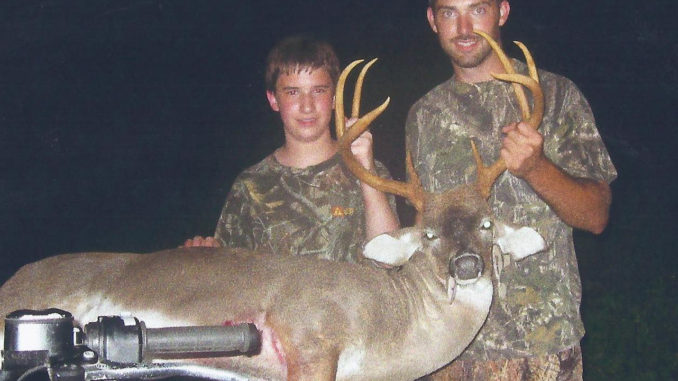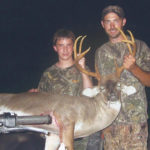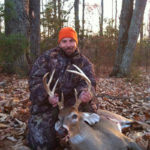
Watch the rut, watch the food, watch the weather and watch your chances for a late-season buck increase.
For more than three months and counting, South Carolina deer hunters have turned out in the deer woods, keeping game processing facilities and taxidermists working late nights and long weekends.
As the intense drive to take a wall-hanger buck begins to wane as Thanksgiving passes, many hunters begin to feel the squeeze and dismay as deer change their habits and no longer pass by stands that are normally productive. But hunters should never throw in the towel, because the December rut arrives like a freight train, allowing crafty hunters the chance to take a trophy during their last stand in the deer woods.
The whitetail rut can seem complicated and very unpredictable, but it is what makes deer season so exhilarating, and it is really not that foreign. Every deer hunter should understand the rut and how it affects deer movements throughout the season, including the last few weeks of December.
The breeding season kicks off as a result of shortening daylight, and in mammals, the onset of darkness causes the pineal gland to secret melatonin into the blood. The increased melatonin levels trigger testosterone in males and induces estrous in females. These two chemical processes generate breeding activity throughout the season. Generally, most does will get bred during the first rut, but the ones that aren’t impregnated in late October or early November are the ones that are chiefly responsible for the intensity of the late-season rut.
Chad Weatherford of Loris is an AWA Whitetail Pro Series hunter who has learned to hunt bucks on unfamiliar properties across North America, and for him, understanding the whitetail breeding cycle is required knowledge. He said December can be a great time to get a nice buck because fewer mates are available.
“Estrous levels will vary daily but will peak several times during the cycle, including the last part of the 90-day period, creating the late-season rut,”he said.
Mammals become sexually-receptive and ovulate during a restricted time period. Breeding must occur during ovulation in order for females to become pregnant, and ovulation lasts only 24 hours. Males are attracted to females during these peaks of the estrous cycle when pheromone levels are high. And as soon as does become pregnant, their estrous cycle ends, and their hormones turn more toward gestation and fetal development.
Luckily for hunters headed to the woods in December, it doesn’t always happen the first time.
“In the South, a lot of does make it through the first rut without getting bred, and some yearling does that did not go into estrous will during the second rut,” Weatherford said.
Because of competition among mates, unaligned sex ratios, hunting pressure and other unnatural or natural disturbances, successful breeding across the herd rarely happens at the right moment or during the first ovulation period.
Depending on the level of receptive does available in December will determine the intensity of the late-season rut, which will vary from year to year. The estrous cycle of unbred does will continue until they are successfully bred, and that may extend the rut well into the winter.
Even though the breeding season is long, bucks’ testosterone levels remain high, and the urge to breed continues to outmatch all other instincts. Even one doe left unbred will fire up a woods full of suitors right to the end of the season. Bucks will continue to seek out these available mates both night and day.
With fewer does fuming up the woods with sex hormones, the competition among males will rise to a new level. By this time, however, most immature bucks are already in the freezer, leaving bigger, more-intelligent bucks to do the final breeding. Hunters can expect to find exceptional rutting activity in the right spots late in the season.
Places where deer spend their December days will differ from spots they were found earlier in the second because of change in weather, hunting pressure and food availability. Deer become vulnerable when they need nutrition the most. Weatherford preys on these weaknesses to encounter a trophy buck looking to score on the few available unbred does.
“Find an area in late December with a good food source, not a lot of pressure and a number of does passing through (and) you may have yourself a late season hot spot,” he said. “Furthermore, food sources are less plentiful, (and) that helps when trying to pinpoint where the does are going to be.”
Many of Weatherford’s December stands will be away from his normal hunting spots.
“A lot of people think all deer go nocturnal during December, but I don’t agree. It may take a little bit of thinking out-of-the box, and you may have to walk a little farther, or you may have a buck bedded in a small head of woods right behind your house that got pushed from the neighboring property,” he said.
Any buck surviving South Carolina’s long deer season and blood-thirsty hunting militia will rarely get caught around established stands where hunters have already logged a good three months.
Dennis Moser of Indian Trail, N.C., is another AWA Whitetail Pro Series hunter who loves to hunt during the late season. He changes up his tactics up during December to find big bucks looking for a love partner.
“Permanent stands are not good places to be in late season,” he said. “The big bucks have figured out these stands are hazardous to their health, but a good food source is still a good place to find bucks in late season.”
Moser chooses areas abundant with food. The best late-season food sources for Moser are generally agriculture fields, late-season food plots or persimmon trees that are still producing fruit.
“Deer will be on persimmon trees that are still producing, but chufa, clover patches and agriculture fields will attract large numbers of deer this time of year, because there is little else out there to eat,” Moser said.
The intensity of the rut is affected by the weather during the early and the late rutting periods. In South Carolina, deer will respond to periods of cold weather following warm spells that are common in late fall and early winter.
“If December is really cold and November was unseasonably hot, the late-season rut will be fantastic,” Moser said.
Hunters should never let the trials and tribulations of their seasons change their hunting agendas for the season’s final month. No doubt, plenty of mistakes have been made over the last few months for both the hunter and the hunted, but one obsession remains to be true: the breeding season is not over and there are does roaming South Carolina’s woodlands without a live fetus in their womb. Hunters with a second wind can score big during the December rut when food and rutting activity is concentrated in the same places. Find these places and success will follow.






Be the first to comment